| Update | Date |
|---|---|
| Amended the path to save the compose file – this is for security, so the container has no access to the file contents. | 14/04/2023 |
Please note that the original version of NZBGet is no longer receiving updates from its developer – It continues to function perfectly, however you may wish to use the actively developed SABnzbd.
What is NZBGet?
NZBGet is an Usenet downloader, it will download releases from Newsgroups and where required will also repair and extract releases. It works on its own or in conjunction with other tools such as Sonarr and Radarr.
Let’s Begin
In the guide I will be taking you through the steps to download and setup NZBGet in Docker.
In order for you to successfully use this guide please complete the three preceding guides
- Step 1: Directory Setup Guide
- Step 2: Setting up a restricted Docker user
- Step 3: Setting up a Docker Bridge Network
Downloading the NZBGet Image
Open up Docker within DSM and navigate to the ‘Registry’ tab, then search for ‘nzbget’. In the list of available containers select the one made by Linuxserver as shown below and click on ‘Download’.

The pop-up box will ask which version you want to download, make sure you choose ‘Latest’ from the list of available versions.
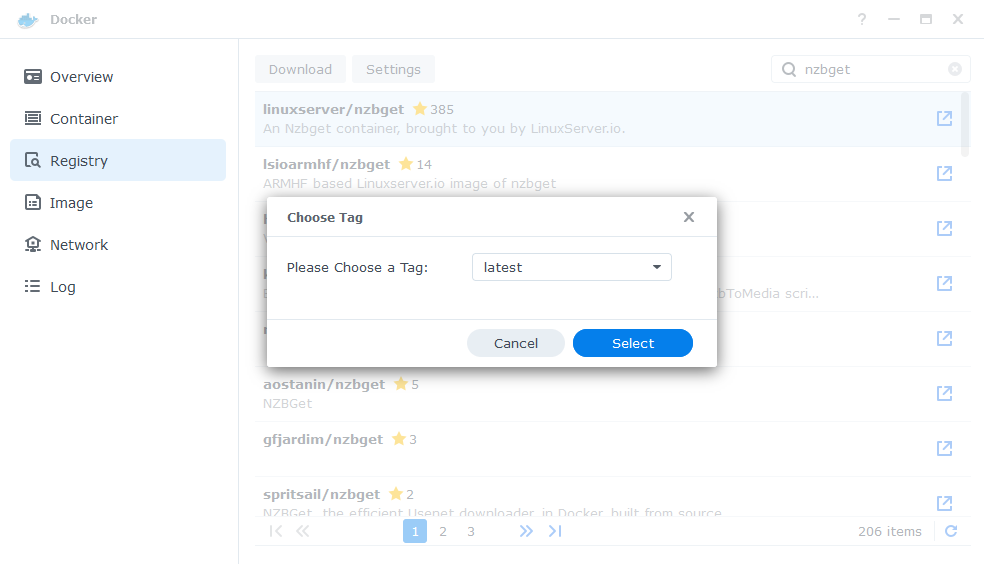
You can check the status of the download over on the ‘Image’ tab.
Setting up the container
In Docker click on the ‘Image’ tab, in the list of your containers select the ‘Linuxserver/ NZBget’ image and click on ‘Launch’
You will be greeted with the Network screen, we will be using the ‘synobridge’ network we created earlier select it from the list and click Next.
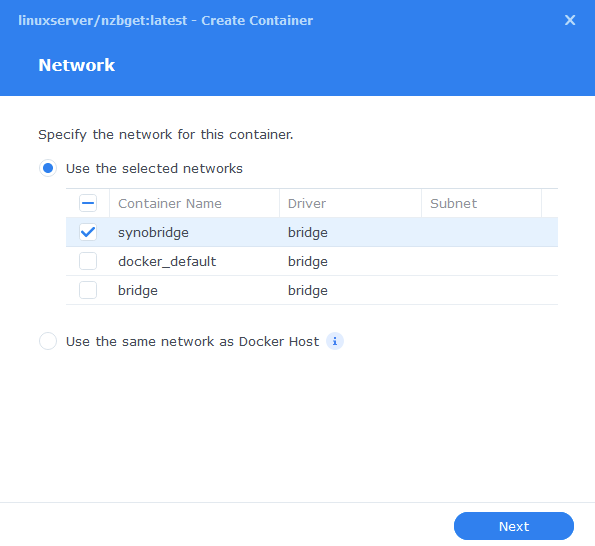
General Settings
Next you will be greeted with the General Settings screen, this is where you can start specifying some of your preferences.
You can change the name of the container to anything you like, and you may want to enable Auto Restart as this will ensure NZBGet starts automatically if you reboot your NAS.
You will also notice a Configure capabilities button — don’t change anything in here!

Next up we are going to click on the ‘Advanced Settings’ button, this will take you to a new window with a number of tabs which we are going to work through.
Environment Variables (PGID, PUID and Timezone)
Next we are going to set up a couple of environment variables that docker will use to allow the container access to our files and folders and also to tell it where we live in the world.
Click the Add button, and fill in the following details as per the table/screenshot, you will need to do one at a time.
| Variable | Value |
|---|---|
| PUID | The UID you obtained in the user setup guide |
| PGID | The GID you obtained in the user setup guide |
| TZ | Your timezone wikipedia.org/wiki/List_of_tz_database_time_zones |

Links/Execution Command
You do not need to set up anything on these tabs.
Press ‘Save’ to go back to the initial setup screen, then press ‘Next’
Port Settings
We won’t be changing any of the ports the container uses. You can repeat the ones shown on the right side of the settings page ‘Container Port’ onto the left side ‘Local Port’ once you have done this press ‘Next’.
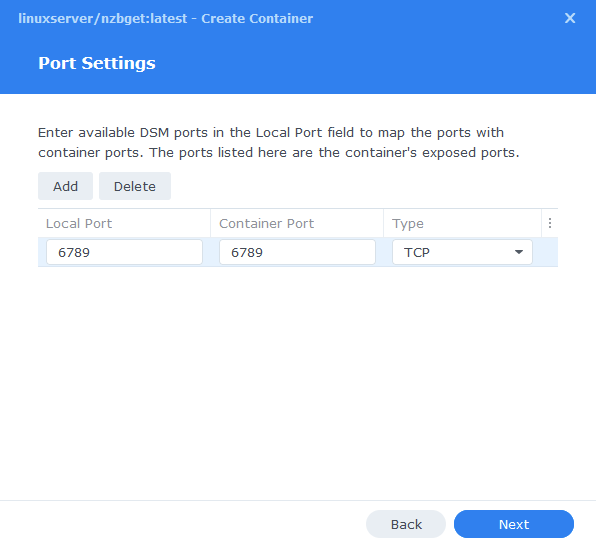
Volume Settings
We will now be specifying the directories where NZBGet will store its configuration files and where to download files to.
First let’s create a folder for the configs, click on ‘Add Folder’ select the ‘docker’ share and create a new sub-folder called ‘nzbget’ click on this folder and click ‘select’

Next repeat this process and select the /data/usenet folder as this is where downloads will be heading.
You will then enter the ‘Mount paths’ as per the table and screenshot below.
| File/Folder | Mount path |
|---|---|
| docker/nzbget | /config |
| data/usenet | /data/usenet |

Click Next to move to the final screen.
Summary
You have now completed the setup of the container.
You will be shown an overall summary of the settings we have specified, this is a good time to double-check everything is correct. Finally, click on Done and the container should start to boot.
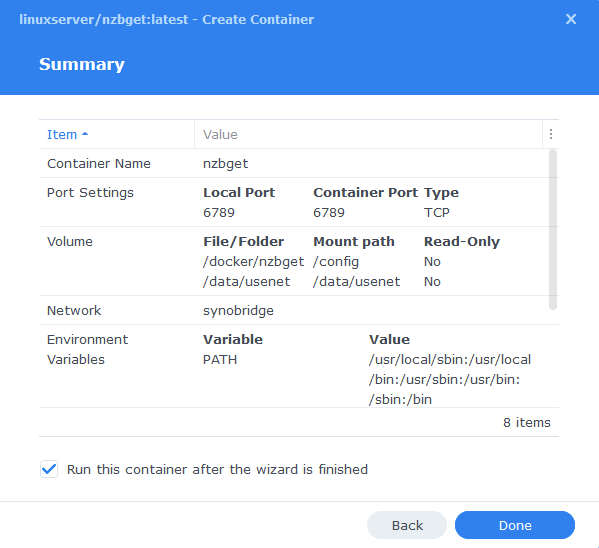
Some final steps
NZBGet will now be running, you can connect to it by going to the IP address of your NAS and port 6789
e.g. 192.168.0.40:6789
The default login details are:
Username = nzbget
Password = tegbzn6789

File Paths
To make sure you file ‘path’ settings are correct, go into settings and change the following value, this will ensure downloads go to the correct place.
| Path | Path to enter |
|---|---|
| MainDir | /data/usenet |

You have now completed the setup and can begin using NZBGet.
| Historic Updates | Date |
|---|---|
| Added Docker Compose details Added new folder mappings to ensure atomic moves and Hard-linking | 03/05/2021 |
| Guide re-written and updated with DSM7 screenshots | 01/08/2021 |
| Updated screenshots and steps for DSM7.1 | 11/06/2022 |
| Added new port settings and Docker Bridge Network | 24/07/2022 |
| Added note regarding ongoing updates of NZBGet | 30/12/2022 |
| Compose version number removed and small wording amendments | 08/04/2023 |
Looking for some help, join our Discord community
If you are struggling with any steps in the guides or looking to branch out into other containers join our Discord community!
Buy me a beverage!
If you have found my site useful please consider pinging me a tip as it helps cover the cost of running things or just lets me stay hydrated. Plus 10% goes to the devs of the apps I do guides for every year.
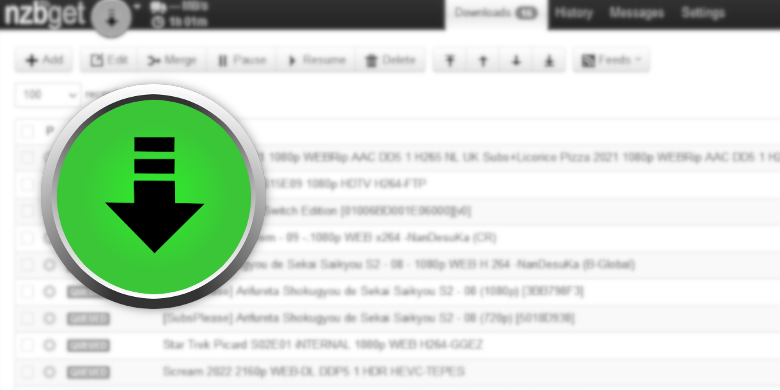



Ahha! I put “media-data” for the File/Folder but for the mount path I put “/data/usenet”, I need to change that to “/media-data/usenet” correct? If so how?
I figured it out! Thanks again for your help and speedy replies.
All good
Setting up for first time with your guides. I need cosign up for a usenet service, and if you had a referral link, I would have used it!
Hey not seen any referal links on the ones I use but thanks for the thought!
Synobridge network is isolated. You will not be able to connect to NZBGET on your NAS. Needs to be Host Network
Hey, you are correct that the ‘synobridge’ Bridge network is isolated within the underlying Docker Networking. But with a bridge network it gives you control over which ports the container can expose to the host network, in this case we only allow the WEBUI port 6789. So you get the benefits of the bridges internal networking between all the containers on it, and also limiting the containers exposed ports.
Thanks, I had successfully installed everything and it’s working!! I have few questions. After a year or so, I completely forgot the URLs for NZBGet, Sonarr and Radarr. I had to go through many guides to get the correct URL. Is there a way to get/figure out the URLs, by looking at the containers or something in Synology?
Secondly, my Sonarr and Radarr showing that there are updates available, but it needs to be installed manually. Is there a guide or steps to do the same, so that I don’t need to perform all the settings/initial setup again? In other words, the manual install shouldn’t wipe the entire setup.
Nzbget run on port 6789, radar 7878 and sonar 8989. So your URL must be http://your-nas-ip:port
Hey Amit
So URLs wise you can see the ports used by the containers by clicking on the Details and looking at the port tab, so it will be your NAS IP followed by that port number. With regards updates check the << sidebar as I have a couple of methods for updating the containers either manually using the Synology UI or Watchtower. You don’t need to update the applications inside the containers themselves as the containers are designed to just be disposed of when an update is required. All your configuration files live safely in the /docker share. (Make sure you have a regular backup of this share in place!)
hope that helps
Thanks a lot for quick reply.. But I don’t see anything in the port settings. I understand that the default ports are mentioned by Louis. But generally I change the default ports most of the time.
I will try the sidebar for the watchtower setup now.
One more question related to synobridge. Either I missed this when I was setting up in 2020 or this was not there at the time. When I am trying to setup syno bridge, what IP range I should give? If my Synology IP is 192.168.1.88, then should I give the IP 192.168.1.0/88 ? Also all my containers are installed, and if I am setting up a synobridge, I think I can stop the containers and add the synobridge now, and then I will also be able to add the port settings?
So the synobridge is a very recent addition – if you followed back in 2020 you are likely running the containers in Host Network Mode. You can easily see this by going to the details of a container and seeing the Network tab, the image below shows Host this will mean the container is 100% running on its default ports.
https://fileshare.drfrankenstein.co.uk/images/host%20mode.png
The other would be a Bridge (default_bridge) mode where it will allow you to specify alternative ports if required. And will look similar to this..
https://fileshare.drfrankenstein.co.uk/images/bridge.jpg
You can see the Network tab specifies the name of the bridge (mine is called deathstar) and the ports tab shows the ports in use, left side (local port) is the one you type in your address and the right (container port) is the actual port the container is using internally)
If you are running as Host you will need to delete the container and set it back up using the synobridge network (you can keep all the files in /docker!)
If it’s running on the default bridge follow the guide on the left menu <<< to set up the bridge network and then attach the container to it.
Hope that helps
IP range can be left blank as Docker will deal with that for you
Going to reply to your synobridge comment as it’s the relevant question 🙂
Hi Dr_Frankenstein, Thanks for your replies. If I need to delete the containers, then I will go to the docker app and then select a particular container, then stop the container, and then click action and delete correct?
If I do above, will it keep the settings which we did earlier? Or we need to redo everything?
Also what do you mean by keep all files under /docker?
Yes exactly that stop and delete just the container from the DSM UI your files are safe in /docker no need to delete them
can you also please comment on the IP addresses for the bridge setup?
Please help. I have no idea what I’m doing wrong. It just comes up this site can’t be reached. Everything is correct.
Glad we fixed this via email, for anyone wondering. Make sure you enter the local port number and don’t leave it blank otherwise you get a random port number assigned to the container.
Thank you so much for these guides, they are so very helpful.
I’m having an issue getting my files to download with nzbget, from both radarr and sonarr.
On nzbget I get the error “Could not create file /data/usenet/tmp/nzb-185.tmp”
Any help? Thanks
On your Synology, the docker-app must have the ownership of the directory mounted by docker as it’s data directory.
I mean the docker-app user.
Hey, double check you have used the correct PUID, and it’s not the wrong way around e.g. PGID should be 100 and the PUID will be the four digit one you got in the user set up guide.
Firstly, thank you for these excellent guides!
I have a similar issue in that I am getting the following:
nzbget.conf(46): Invalid value for option “NzbDir” (/media-data/usenet/nzb): could not create directory : No such file or directory
nzbget.conf(52): Invalid value for option “QueueDir” (/media-data/usenet/queue): could not create directory : No such file or directory
I have followed your initial setup guide and have the same structure, except I’ve named “data” as “media-data”. I have double checked the PUID and PGID and they are correct. I tried, per Louis’ suggestion to set the permissions of the usenet folder and sub-directories to the docker user, but this didn’t solve the issue either.
Hey, when mapping the folders did you change the /data on the inside of the container to /media-data/usenet as well?
Yes I am sure I did…. However, worth checking if you could let me know how?
It will show you on the container details screen under the volume section within the Synology Docker UI.